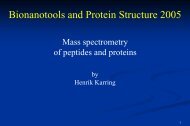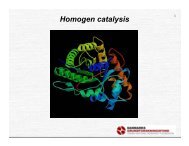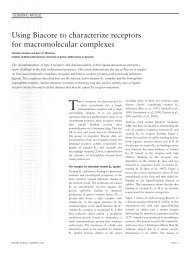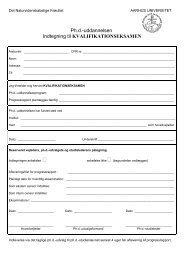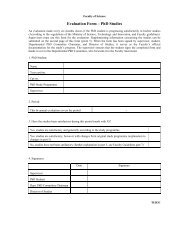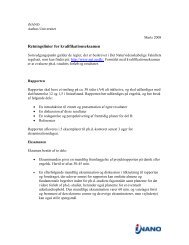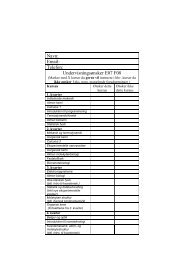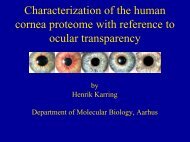Functional genomics by mass spectrometry
Functional genomics by mass spectrometry
Functional genomics by mass spectrometry
Create successful ePaper yourself
Turn your PDF publications into a flip-book with our unique Google optimized e-Paper software.
FEBS 23894 FEBS Letters 480 (2000) 25-31<br />
Minireyiew<br />
<strong>Functional</strong> <strong>genomics</strong> <strong>by</strong> <strong>mass</strong> <strong>spectrometry</strong><br />
Jens S. Andersen, Matthias Mann*<br />
Protein lnteraction Laboratory, University of Southern Denmark, DK 5230 Odense M, Denmark<br />
Received 19 May 2000<br />
Edited <strong>by</strong> Gianni Cesareni<br />
Abstraet Systematic analysis of the function of genes ean take<br />
plaee at the oligonucleotide or protein level. The latter has the<br />
advantage of being closest to funetion, since it is proteins that<br />
perform most of the reactions necessary for the cello For most<br />
protein based ('proteomic') approaches to gene function, <strong>mass</strong><br />
<strong>spectrometry</strong> is the method of ehoice. Mass <strong>spectrometry</strong> ean<br />
now identify proteins with very high sensitivity and medium to<br />
high throughput. New instrumentation for the analysis of the<br />
proteome has been developed including a MALDI hybrid<br />
quadrupole time of flight instrument which combines advantages<br />
of the <strong>mass</strong> finger printing and peptide sequencing methods for<br />
protein identification. New approaches include the isotopic<br />
labeling of proteins to obtain accurate quantitative data <strong>by</strong> <strong>mass</strong><br />
<strong>spectrometry</strong>, methods to analyze peptides derived from emde<br />
protein mixtures and approaches to analyze large Bombers of<br />
intact proteins <strong>by</strong> <strong>mass</strong> <strong>spectrometry</strong> directly. Examples from<br />
this laboratory iIIustrate biological problem solving <strong>by</strong> modem<br />
<strong>mass</strong> spectrometric techniques. These include the analysis of the<br />
structure and funetion of the nucleolus and the analysis of<br />
signaling eomplexes. @ 2000 Federation of European Bioehemical<br />
Societies. Published <strong>by</strong> Elsevier Science B.V. All<br />
rights reserved.<br />
Key words: Proteomies; Protein-protein interaetion; Protein<br />
identifieation; Genomies; Nucleolus; Signaling;<br />
Phosphorylation<br />
1. Introduction<br />
During the 80's and partieularly the 90's biologieal <strong>mass</strong><br />
speetrometry has beeome a powerful method for the eharaeterization<br />
of biomoleeules sueh as proteins and nucleie acids.<br />
The main driving forees for this development have been novel<br />
ionization teehniques whieh eould transfer the biomoleeules<br />
from the liquid phase to the gas phase whieh make them<br />
amenable to measurement in the <strong>mass</strong> speetrometer. The<br />
two dominant methods are eleetrospray ionization [I] and<br />
matrix assisted laser desorption ionization [2,3] whieh <strong>by</strong> historieal<br />
eoineidenee were introdueed to large biomoleeules at<br />
the same time. With these two methods, the 90's have seeRthe<br />
applieation of eoneepts sueh as peptide mapping, whieh eould<br />
only be used on large amounts of sample befare, to more<br />
realistie protein amounts today. The deteetion of posttranslational<br />
modifieations also beeame mach easier and more sensitive<br />
with these methods. In 1993 a Romber of groups [4-8]<br />
published a method to eorrelate the <strong>mass</strong> speetrometrie information<br />
eontained in a peptide <strong>mass</strong> map with the information<br />
in the expanding protein sequenee databases. Even though<br />
'<strong>mass</strong> fingerprinting' needed several more years to beeome a<br />
praetieally viable method for protein identifieation, in retrospeet<br />
the pubIieation of these papers marked the turning point<br />
at whieh <strong>mass</strong> speetrometry beeame a large seRIeor 'funetional<br />
genomies' teehnique. They showed for the first time that<br />
<strong>mass</strong> speetrometry eould in principle handle large numbers of<br />
proteins, similarly to oligonucleotide based methods. Shortly<br />
afterwards, two methods were introdueed whieh allowed the<br />
lise of peptide fragmentation data for mach more speeifie<br />
identifieation of proteins [9-Il].<br />
During the last deeade <strong>mass</strong> speetrometrie instrumentation<br />
and proeedures have been improved to a remarkable degree,<br />
inereasing sensitivity of analysis and aeeuraey of resuIts <strong>by</strong><br />
orders of magnitude. This development seems set to eontinue<br />
in the future and wilI fuel additional advanees.<br />
In 1994, the term 'proteomies' was eoined to designate the<br />
large seRIeeharaeterization of the entire protein complement<br />
of a eell line, tissue or organism [12-14]. At the time, proteome<br />
analysis was mainly assoeiated with the display of<br />
erude protein mixtures, sueh as tissue homogenates, on twodimensional<br />
gels. Differenees between the displayed spots in<br />
the normal and diseased state, for example, would be measured<br />
<strong>by</strong> image analysis of the stained protein spots and<br />
would eorrelate with the disease. A erueial and previously<br />
diffieuIt step was the identifieation of sueh spots. In 1996 a<br />
first large seale protein identifieation projeet was performed<br />
whieh unambiguously demonstrated that <strong>mass</strong> speetrometry<br />
had the sensitivity, speeificity and throughput to perform<br />
this task [15].<br />
Reeently, attention has shifted to 'funetional proteomies', in<br />
whieh proteins are purified with a speeifie funetion in mind.<br />
Examples of sueh approaehes are affinity purifieation to obtRin<br />
binding partners of a protein of interest, purifieation of<br />
an organelle, or purifieation of a multi-protein eomplex with a<br />
defined funetion. This type of proteomies has beeome very<br />
sueeessful and wilI eontinue to deIiver answers to biologieal<br />
questions whieh would be very hard to obtain otherwise. Below,<br />
we wiII deseribe principles involved in the <strong>mass</strong> speetrometrie<br />
analysis of proteins, review recent advanees in the instrumentation<br />
and novel approaehes in proteomies <strong>by</strong> <strong>mass</strong><br />
speetrometry. Finally, we wilI iIIustrate same of the funetional<br />
proteomie approaehes with examples from Dur laboratory.<br />
2. Mass speetrometry in proteomics and in functional <strong>genomics</strong><br />
*Corresponding author. http://www.pi!.sdu.dk.<br />
E-mai!: mann@bmb.sdu.dk<br />
In proteomies the premier task of <strong>mass</strong> speetrometry is the<br />
identifieation of very low leveIs of protein whieh have been<br />
0014-5793/00/$20.00 «:J 2000 Federation of European Biochemica1 Societies. Published <strong>by</strong> Elsevier Science RY. All rights reserved.<br />
PIl: SOO 14-579 3(00)0 177 3- 7
26<br />
separated <strong>by</strong> one- or two-dimensional gel electrophoresis. Protocols<br />
for high sensitivity preparation of gel separated protejns<br />
have been published [16-18]. Proteins an\ tiest degraded<br />
into peptides <strong>by</strong> sequence specific proteases such as trypsin.<br />
Peptides are preferred for MS analysis, since proteins cannot<br />
easiJy be eluted from gels without detergents like SDS (which<br />
are detrimental to <strong>mass</strong> <strong>spectrometry</strong>) and because large protejns<br />
are usually heterogeneous and hence possess no single<br />
molecular weight which can be related to the corresponding<br />
entry in a sequence database. The <strong>mass</strong>es of a set of peptides<br />
can be measured <strong>by</strong> matrix assisted laser desorption ionization<br />
(MALDl) where a co-precipitate of light absorbing matrix<br />
(usually a-cyano-4-hydroxycinnamic acid or dihydroxy benzoic<br />
acid) and the peptide solution is irradiated with a short<br />
pulse of VY light in the vacuum. Same of the released peptides<br />
are ionized <strong>by</strong> attachment of protons and are accelerated<br />
in a strong electric fieid. After being turned around <strong>by</strong> an<br />
energy correcting ion mireDethey are then detected on a channeltron<br />
detector. The result of this measurement is a time of<br />
flight distribution of the peptides in the supernatant of the<br />
trypsin digested protein (TOF <strong>mass</strong> <strong>spectrometry</strong>). After determining<br />
the peak centroids and calibrating the spectrum, for<br />
example on trypsin auto-digestion products, a set of highly<br />
accurate peptide <strong>mass</strong>es is obtained. With state of the art<br />
MALDI <strong>mass</strong> spectrometers, peak resolution of about<br />
10000 and a <strong>mass</strong> accuracy of a few parts per million is<br />
flOWpossible. Recording the <strong>mass</strong> spectrum can be done manually<br />
in a few minutes and has also been entirely automated<br />
using fuzzy logic feedback control [19]. Fig. la shows the<br />
peptide <strong>mass</strong> map obtained fully automatically from a gel<br />
separated protein from the malaria parasite.<br />
The MALDI peptide <strong>mass</strong> mapping, or '<strong>mass</strong> fingerprinting'<br />
method has the advantage of being scalable. Many sampies<br />
can be deposited on a single probe holder and measured<br />
in a single run. Together with automated and high sensitivity<br />
preparation of the proteins for analysis, hundred s of proteins<br />
can be handled in this format.<br />
Vnfortunately, not all protein s are amenable to identificalian<br />
<strong>by</strong> peptide <strong>mass</strong> mapping alone. A large percentage of<br />
human proteins are still not represented full length in sequence<br />
databases, small proteins sometimes do not result in<br />
a sufficient number of tryptic peptides for unambiguous identification<br />
and mixtures of proteins can only be 'deconvoluted'<br />
to their respective entries in the databases with special interpretation<br />
[20,21].In many of those cases, a further step - <strong>mass</strong><br />
spectrometricsequencingof the peptides- is required.<br />
Electrospray <strong>mass</strong> <strong>spectrometry</strong> is a different but complementary<br />
method to identify proteins [I]. A solution containing<br />
the peptides is pumped through a metal capillary and dispersed<br />
at high voltage, resulting in rapidly evaporating, peptide<br />
containing droplets. After desolvation, the peptide molecules<br />
remain charged <strong>by</strong> attachment of Olle or a few protons<br />
and are drawn into the vacuum of a <strong>mass</strong> spectrometer. In the<br />
<strong>mass</strong> spectrometer, the ions are separate d <strong>by</strong> dynamic electric<br />
fields according to their <strong>mass</strong> to charge ratios. After a <strong>mass</strong><br />
spectrum is obtained, the instrument can be instructed to pass<br />
only a particular ion species into a 'collision chamber' where<br />
this ion species collides with nitrogen or argon gas at low<br />
pressure. Multiple impacts result in fragmentation of the peptide<br />
species, usually along the peptide band. The C-terminal<br />
containing fragments are designated Y"-ions and the N-terminal<br />
containing fragments are designated B-ions [22]. A series<br />
J.S. Andersen, M. MannlFEBS Letters 480 (2000) 25-31<br />
a 100 1763.846 2291.067 1462.617<br />
T<br />
842.510 MH+<br />
~<br />
.E il!<br />
] 50<br />
"<br />
." > ol<br />
";j<br />
'"<br />
1460 1465<br />
o 2000<br />
b 100 664.31<br />
~<br />
.E<br />
il!<br />
8<br />
..s 50<br />
"<br />
.:':<br />
1;j<br />
";j<br />
'"<br />
451.20<br />
(M+2H)2+<br />
578.62 *<br />
664.31<br />
617.57 I 707.83<br />
o 400 600 700 800 900<br />
500<br />
c 100 B2<br />
~<br />
.E il! "<br />
,Ej50<br />
."<br />
~ ol<br />
;:!<br />
B,<br />
Y'; Y'6<br />
693.37 822.41<br />
o ~<br />
800<br />
B7 --r-<br />
200 400<br />
600<br />
mIz<br />
Y<br />
662 66<br />
Y"<br />
Y" 8<br />
7 1098.55<br />
985.47<br />
1000<br />
!IL<br />
1200<br />
Fig.!. a: PepIide <strong>mass</strong> map of a Plasmodium falciparum malaria<br />
protein obtained from an in-gel digest of a spot from a 2D gel. The<br />
list of <strong>mass</strong>es unambiguously identified gene 14-3-3 in the database<br />
with 13 peptides matching the caIculated tryptic peptide <strong>mass</strong>es<br />
within 30 ppm. Two tryptic peptides (T) were used for calibration<br />
of the spectrum. (The proteins were analyzed using the automated<br />
analysis at Protana AiS, Odense, Denmark.) b and c: Identification<br />
of a human protein <strong>by</strong> nanoelectrospray <strong>mass</strong> <strong>spectrometry</strong>. b: Mass<br />
spectrum of the tryptic peptides from an in-gel digest. Marked<br />
peaks were fragmented and correspond to peptides from Nop5.<br />
c: Fragment <strong>mass</strong> spectrum of the doubly charged peptide ion at<br />
mlz 664.31. The sequence tag E-Y-I/L is derived from the <strong>mass</strong><br />
difference of peptide fragments. The sequence, together with the<br />
start and end <strong>mass</strong> of the fragmentation series and the peptide<br />
<strong>mass</strong>, was combined into the search string (693.34)EYL(l098.52)<br />
and searched in a non-redundant database. The retrieved sequence<br />
TQLYEYLQNR was matched against the tandem <strong>mass</strong> spectrum.<br />
The position of the assigned series of N-terminal (B-ions) and C-terminal<br />
(Y"-ions) are marked.<br />
of B- or Y"-ions spelIs out a partial sequence given <strong>by</strong> the<br />
mblecular weight differences between the fragments (for exampie,<br />
a <strong>mass</strong> difference between three adjacent y" fragment ions<br />
at <strong>mass</strong>es 500, 613, and 684 would spell out the sequence IG<br />
in the C- to N-terminal direction, where I could be isoleucine<br />
or leucine which have the same <strong>mass</strong> and cannot be distinguished).<br />
In the last few years the triple quadrupole <strong>mass</strong> spectrometer,<br />
in which the tiest, isolating, <strong>mass</strong> spectrometer and the<br />
part of the <strong>mass</strong> spectrometer which separates the fragments<br />
were both of the quadrupole type, has largely been displaced<br />
<strong>by</strong> the quadrupole time of flight instrument. In this instrument,<br />
the fragments are detected <strong>by</strong> TOF <strong>mass</strong> <strong>spectrometry</strong>,<br />
like they are in the MALDI method. Resolution and <strong>mass</strong>
J.S Andersen, M. MannlFEBS Letters 480 (2000) 25-31<br />
accuracy are likewise in the range of 10000 and low ppm,<br />
respectively. Such high performanee usually leads to unambiguous<br />
and straightforward identification on the basis of Olleor<br />
a few peptides which have been fragmented. Fig. Ib shows the<br />
<strong>mass</strong> spectrum of the peptides of a human protein. The peptide<br />
at <strong>mass</strong> to charge ratio of 664.31 was selected and fragmented,<br />
resulting in the fragment <strong>mass</strong> spectrum shown in<br />
Fig. Ic. The <strong>mass</strong> difference between the marked peaks spelIs<br />
the sequence EYI which, together with the <strong>mass</strong> of the peptide<br />
and the <strong>mass</strong> of the fragments, uniquely identified the sequence<br />
TQLYEYLQNR in the non-redundant database containing<br />
more than 350000 proteins. Calculated fragments for<br />
that sequence fil IS fragment peaks in the spectrum within<br />
0.05 Da. Fragmentation of several additional peptides likewise<br />
uniquely identified the same protein in the database.<br />
Peptide delivery from the gel supernatant after digestion of<br />
the protein ean happen in two ways: In the 'nanoelectrospray'<br />
approach [23-26] the peptide mixture is micropurified in a<br />
small capillary packed with a small volume (100 nI) of reverse<br />
phased material. Peptides are eluted into a very fine tipped<br />
'spraying needle' which supports sequencing ruDS of more<br />
than 30 min on I 111of peptide solution. Peptides ean be<br />
selected in turn for sequencing and peptide sequence tags<br />
ean be obtained on a large number of peptides. Proteins ean<br />
be identified in 'real time' during the experiment and the remainder<br />
of the sequencing time ean be focused on miner<br />
components of a mixture or on potentially modified peptides.<br />
This approach has proven very robust and has helped salve a<br />
large number of important biological problems (see for exampie<br />
[27-30]). In the liquid chromatography/<strong>mass</strong> <strong>spectrometry</strong><br />
approach (LC/MS), peptides are separated <strong>by</strong> a reversed<br />
phase chromatograph whose effluent is directly coupled to<br />
the <strong>mass</strong> spectrometer. Peptides are sequenced 'on-line' as<br />
they elute from the column [31-33]. Advantages of this approach<br />
inc1ude the potential to automate sample introduction<br />
and the faet that the peptides elute in a small volume, increasing<br />
the <strong>mass</strong> spectrometric response. LC/MS is aften perforrned<br />
with an 'ion trap', a small relatively simple <strong>mass</strong> spectrometer<br />
which ean automatically sequence and obtain<br />
tandem <strong>mass</strong> spectra at relatively high sensitivity [34]. Database<br />
searching is then aften performed with correlating uninterpreted<br />
tandem <strong>mass</strong> spectra against the ca1culated <strong>mass</strong><br />
spectra of all the peptides in the database [11,35].<br />
Most <strong>mass</strong> spectrometric facilities ean new identify proteins<br />
at about the I pmollevel (50 to lODng of protein) of protein<br />
initially applied to the gel. Specialized laboratories have<br />
achieved sensitivities in the low ng range (weak silver stained<br />
levels). Mass <strong>spectrometry</strong> itself is exquisitely sensitive, requiring<br />
only a million or so molecules for detection. Therefore we<br />
believe that the impressive gain in sensitivity achieved over the<br />
last decade (more than a thousand-fold) will continue in the<br />
future as various bottlenecks in the identification process are<br />
addressed.<br />
3. Novel developments in <strong>mass</strong> <strong>spectrometry</strong> and <strong>mass</strong><br />
spectrometric approaches to proteomics problems<br />
3.1. MALDI quadrupole time of jlight instrument<br />
An interesting instrument was developed recently, which<br />
combines advantages of the MALDI peptide mapping approach<br />
and the peptide sequencing method [36,37]. Briefly, a<br />
MALDI ion source is placed in front of a quadrupole TOF<br />
+<br />
Quadrupoles<br />
Q, 'h<br />
+<br />
Reflectron<br />
Time-of-Flight<br />
analyzer<br />
N2<br />
--<br />
ton<br />
= Mi,,", =<br />
III<br />
-~<br />
Doteetor<br />
Fig. 2. Schematic of the MALDI quadruple time of Ilight instrument.<br />
Ions are created <strong>by</strong> the MALDI process and are accelerated<br />
into the quadrupole sections. To obtain the peptide <strong>mass</strong> spectrum<br />
sections Qo, Q, and Q2 are all operated in transmission mode and<br />
the ions are separated in the time of Ilight <strong>mass</strong> spectrometer. After<br />
obtaining the <strong>mass</strong> spectrum, an individual peptide species ean be<br />
selected <strong>by</strong> section Qt. This ion species is fragmented <strong>by</strong> collision<br />
with argon or nitrogen gas in Qz. The fragments are analyzed with<br />
very high resolution and <strong>mass</strong> accuracy in the time of Ilight section.<br />
In a single experiment many peptide ion species ean be sequenced.<br />
instrument (MALDI QSTAR). Peptide <strong>mass</strong> mars are obtained<br />
<strong>by</strong> first passing the ions through the quadrupole section<br />
and then analyzing them <strong>by</strong> the TOF part. Individual peptide<br />
species ean then be isolated, fragmented in the collision cell<br />
and analyzed <strong>by</strong> TOF. Fig. 2 shows a schematic of the instrument.<br />
In Dur experience, the MALDI QSTAR ean achieve<br />
sub-picomole sensitivities on gel separated proteins, and identifications<br />
are very specific. Throughput is currently limited <strong>by</strong><br />
the number of ions generated and transmitted. Developments<br />
new under way should increase this number at least ten-fold.<br />
We anticipate that the MALDI quadrupole time of flight instrument<br />
will play a major fOle in proteomics as the 'work<br />
horse' for protein identification.<br />
3.2. Genome searching<br />
To date, only protein sequence databases (usually autotranslated<br />
from DNA sequence data) and expressed sequence<br />
tag databases have been searched <strong>by</strong> <strong>mass</strong> spectrometric data.<br />
It has been shown that virtually all human proteins which ean<br />
be visualized on gels ean be identified in the expressed sequence<br />
tag databases, which new contain more than two million<br />
single read cDNA sequences [38].However, ESTs usually<br />
cover only part of a protein sequence. If it were possible to<br />
work directly with genomic sequence databases, this would in<br />
principle allow for the identification of every peptide on which<br />
<strong>mass</strong> spectrometric sequence information was obtained. Difficulties<br />
in genorne searching inc1ude the large size of the human<br />
genorne and the faet that only a few percent are protein<br />
coding. Additionally, the exon-intron structure of most genes<br />
cannot be accurately predicted <strong>by</strong> bioinformatics [39,40]. Recent<br />
results obtained in Dur group [41], however, show that a<br />
suitably modified peptide sequence tag algorithm has enough<br />
specificity to uniquely locate peptides in raw genomic data.<br />
Furthermore, the <strong>mass</strong> spectrometric data helps in predicting<br />
the gene structure.<br />
27
28<br />
3.3. Analyzing erude mixtures of proteins without gel<br />
eleetrophoresis<br />
Several interesting approaches have been taken recently towards<br />
the analysis of the proteome without the lise of gel<br />
electrophoresis. In Ollesuch approach, the protein population<br />
is separated <strong>by</strong> a variant of capillary electrophoresis and the<br />
intact proteins are then eluted into a Fourier transform ion<br />
cyc1otron resonance <strong>mass</strong> spectrometer (FT ICR). The FT<br />
ICR is capable of storing the ions and measuring them at<br />
extremely high resolution and <strong>mass</strong> accuracy using a frequency<br />
based method. Measurement of several hundreds protein<br />
components from lysates of Eseheriehia eo/i or yeast has<br />
already been shown [42]. Usinga variant of the tandem <strong>mass</strong><br />
spectrometric method, it mayaiso be possible to identify the<br />
proteins 'on-line' as they flute into the <strong>mass</strong> spectrometer<br />
[43,44]. Several practical problems remain to be solved for<br />
this type of proteomic analysis to be successful. Furthermore,<br />
as mentioned above, larger proteins, even when they can be<br />
measured <strong>by</strong> this method, will have a molecular weight distribution<br />
rather than a single molecular weight.<br />
In another approach, emde protein mixtures are digested in<br />
solution without separation. The resulting peptide mixture is<br />
then analyzed <strong>by</strong> the LC/MS method outlined above [45,46].<br />
As the capacity of the <strong>mass</strong> spectrometer to sequence co-eluting<br />
peptides increases, more and more complex protein mixtures<br />
can be analyzed. It is c1ear, however, that in any direct<br />
analysis of very emde protein mixtures the major proteins will<br />
tend to mask the miner components. This 'dynamic range<br />
problem' is a key difficulty in any kind of unbiased analysis<br />
of emde mixtures such as tissue homogenates or cell lysates.<br />
3.4. Quantitation <strong>by</strong> <strong>mass</strong> speetrometry<br />
The signal intensity of the peptides in the <strong>mass</strong> spectrometer<br />
cannot directly be used to derive the quantity of the protein.<br />
Instead the staining intensity together with a rough estimate<br />
of the <strong>mass</strong> spectrometric response have usually been harnessed<br />
to determine the protein amount. Recently, isotopic<br />
labeling methods have been introduced into <strong>mass</strong> spectrometric<br />
proteome studies [47,48]. A stable isotope label is introduced<br />
into Olleof the two sampies that are to be quantitated<br />
relatively to each other. These sampies are then mixed and the<br />
ratio between peptide with isotopic label and without, accurately<br />
determines the ratio. Labels can for example be introduced<br />
through Nl5 media, through the blocking group employed<br />
in blocking reactive cysteines in the proteins or <strong>by</strong><br />
derivatization of the N-termini of peptides. These techniques<br />
new aren up for accurate quantitation in a wide range of<br />
proteomic situations.<br />
4. Applications of <strong>mass</strong> <strong>spectrometry</strong> in proteomics<br />
Mass <strong>spectrometry</strong> is flOWalmost universally used as the<br />
identilication method in 'expression proteomics' with two-dimensional<br />
gels of two different biological states. Such applications<br />
are not reviewed here but can be found, for example,<br />
in special issues of E1ectrophoresis as well as many recent<br />
reviews [49-55]. A common difficulty in such projects has<br />
been that it was difficult to extract biological mechanism<br />
from the up or down regulation of the abundant cellular protejns<br />
which are usually displayed in such mars. Furthermore,<br />
this approach is new superseded in many circumstances <strong>by</strong> the<br />
powerful oligonuc1eotidechip approaches [56].Instead we will<br />
J.S. Andersen, M. Mann/FEBS Letters 480 (2000) 25-31<br />
NF-KB<br />
IKB pepude<br />
-<br />
NF-KB<br />
-NF-KB<br />
peptide<br />
NF-KB<br />
pepude<br />
-<br />
Fig. 3. Isolation of proteins associated with the phosphorylated lK:B/<br />
NFKB protein complex. 35S-radiolabeled HeLa Iysate was incubated<br />
with antibody immobilized I1I:B/NFKB complex in the presence of<br />
phosphorylated IKB pep tide (lane I) or serine substituted IKB peptide<br />
(lane 2). The immune complexes were then washed, eIuted and<br />
analyzed <strong>by</strong> SOS-PAGE and autoradiography. Tryptic peptides derived<br />
from the marked bands from beth Janes were carefully investigated<br />
<strong>by</strong> nanoelectrospray tandem <strong>mass</strong> <strong>spectrometry</strong> and resulted<br />
in the identification of the E3 ligase receptor subunit of IKB [66].<br />
focus on same successful examples from our laboratory of<br />
'functional proteomics' in which organelle purification or affinity<br />
purification was used as a direct lead into biological<br />
function.<br />
4.1. Multi-protein eomplexes<br />
Multi-protein complexes, or 'molecular machines', are assemblies<br />
with a particular function such as splicing, transport<br />
or nuc1ear importlexport. Olle lise of proteomics technology is<br />
to determine the make up of such complexes [57,58]. To this<br />
end, they need to be purilied specifically, the identity of the<br />
factors in the complex needs to be determined and finally the<br />
in vivo presence of the novel members of the complex needs to<br />
be established. In collaboration with Lamond's laboratory, we<br />
have extensively characterized the human spliceosome in this<br />
way. The spliceosome was assembled on a model biotinylated<br />
and radioactively labeled pre-messenger RNA. The complex<br />
was pulled out of the radioactive fraction after gel filtration<br />
using the biotin-streptavidin system. The spliceosome associated<br />
proteins were then separated and visualized <strong>by</strong> two-dimensional<br />
gel electrophoresis. More than 70 protein spots<br />
were analyzed. In a single experiment, 19 novel splicing factors<br />
were found. Interestingly, all the novel proteins could be<br />
identilied, and many c1oned in a straightforward manner, using<br />
EST libraries and physical EST c1onesas reagents [38]. In<br />
vivo confirmation of the involvement of these factors in splicing<br />
was obtained <strong>by</strong> fusing novel genes with green fluorescence<br />
protein (GFP) and observing co-localization with<br />
known spliceosomal protein. Several of the novel proteins<br />
are new further being studied in our laboratories with the<br />
help of proteomic techniques. For example, proteins can be<br />
epitope tagged and incubated with nuc1ear extract. The eluted<br />
and gel separated proteins can again be analyzed <strong>by</strong> <strong>mass</strong><br />
<strong>spectrometry</strong> to reveal more detailed involvement in sub-complexes<br />
of the spliceosome, in this case.<br />
A large number of multi-protein complexes has new been<br />
analyzed, inc1udingthe nuc1ear pore complex in yeast [59],the<br />
spindle pele body in yeast [60], the Arp2/3 complex [61] and
'<br />
'<br />
J.s. Andersen, M. Mann/FEBS Letters 480 (2000) 25-31<br />
many others. The yeast ribosome [62]and the 'interehromatin<br />
granule' [63] have been studied <strong>by</strong> digesting the full eomplement<br />
of proteins in solution and identifying as many protein s<br />
as possible <strong>by</strong> the LC/MS method mentioned above. Crueial<br />
issues in the large scale analysis of multi-protein complexes <strong>by</strong><br />
<strong>mass</strong> <strong>spectrometry</strong> are the effieient tagging and purifieation of<br />
the 'bait' with the associated 'prey' proteins. Advances are<br />
being made in this area as well, for example <strong>by</strong> using two<br />
functionalities in the tag (calmodulin binding and Z-tag [64]<br />
or <strong>by</strong> using two epitope tags).<br />
Chemical cross-linking is another method that ean be employed<br />
to study multi-protein complexes. For example, OUT<br />
laboratory has performed limited eross-linking on the<br />
Nup85 sub-complex of the nuclear pore [65]. In addition to<br />
the proteins in the sub-complex additional bands appear<br />
which contain cross-linked proteins. Pairs or triplets of such<br />
proteins yielded nearest neighbor relationships which were<br />
used to build a crude topological model of the complex.<br />
proteins were identified in the band and the control but two of<br />
the peptides were absent in the control. These identified a<br />
Drosophila protein and a human EST, leading to the cloning<br />
of the receptor (now named E3RSl1cB)[66].<br />
In a different approach, we have precipitated tyrosine phosphorylated<br />
proteins in the epidermal growth factor receptor<br />
(EGFR) pathway. Cells were stimulated <strong>by</strong> EGF and phosphorylated<br />
proteins were precipitated <strong>by</strong> anti-phosphotyrosine<br />
antibodies [67]. Nine proteins specific to tIDSpathway were<br />
identified <strong>by</strong> comparison of the immuno-precipitates between<br />
stimulated and non-stimulated cells. Interestingly, even in<br />
such a well studied pathway, Olle protein, vav-2, was found<br />
which was not previously known to be involved and a completely<br />
novel protein was cloned. Note that in this procedure,<br />
protein s are preeipitated both from the complex that farms<br />
directly at the intracellular domain of the receptor as well as<br />
members of the cascade that are further downstream and do<br />
not have physical contact to the receptor.<br />
29<br />
4.2. Signaling pathways<br />
Proteomic methods have also been used in OUTlaboratory<br />
to study more transient rather than struetural complexes.<br />
Many signaling cascades are transmitted through multi-protein<br />
complexes involving scaffolds and these complexes can be<br />
biochemically purified, In collaboration with Ben-Neriah we<br />
have assembled the NFKB signaling complex on beads to<br />
which NFKB antibody was immobilized. When the NFKB<br />
pathway is stimulated, the IKBs which normally proteet the<br />
nuclear localization sequence in NFKB are phosphorylated<br />
and then degraded <strong>by</strong> the ubiquitination machinery. The specific<br />
receptor which recognizes the phosphorylated epitope<br />
was not known at the time of this study. In stimulated, proteasorne<br />
inhibited cells, the receptor was specificallyvisualized<br />
when the complex was incubated with a phosphorylated versus<br />
a non-phosphorylated synthetic peptide corresponding to<br />
the sequence of IKBwhich is phosphorylated uran stimulation<br />
(see Fig. 3). Olle-dimensional gels revealed subtle differences<br />
in eluted proteins and the corresponding bands were sequenced<br />
<strong>by</strong> nanoelectrospray <strong>mass</strong> <strong>spectrometry</strong>. Six different<br />
a<br />
-- /<br />
b<br />
=<br />
MALDI-MS -<br />
""-<br />
.~<br />
-.<br />
.<br />
""""= ~;~:<br />
;~<br />
'- -<br />
~ .~ :e<br />
-<br />
~ =<br />
~~<br />
~ 100<br />
"<br />
:550<br />
"<br />
.~<br />
u ::<br />
Protein 4<br />
(nrdb)<br />
4.3. Organelles<br />
Apart from multi-protein complexes, organelles can also be<br />
purified and their composition analyzed <strong>by</strong> <strong>mass</strong> speetrometTY.Since<br />
organelles are aften less well defined than smaller<br />
multi-protein complexes, the task of verification of identifieatjans<br />
becomes even more important.<br />
Working with the laboratory of Lamond we are purifying<br />
and identifying the components of various nuclear struetures.<br />
Fig. 4 shows a olle-dimensional gel of human nucleolar protejns<br />
purified from HeLa cells. Slicing the gel into pieees and<br />
analyzing the main protein components in every sliee <strong>by</strong><br />
MALDI <strong>mass</strong> fingerprinting and nanoelectrospray peptide sequencing<br />
identified more than Ollehundred proteins. Interestingly,<br />
many of the proteins did not appear on two-dimensional<br />
gel of the same preparation. Same of the proteins were tao<br />
large or tao hydrophobic for two-dimensional gel analysis but<br />
others also appear to have been tao basic for the range of<br />
isoelectrie focusing used in OUTgel system (pI 3-10). We anticipate<br />
that many organelles will now be purified and analyzed<br />
<strong>by</strong> <strong>mass</strong> <strong>spectrometry</strong>. For the first time it will be pos-<br />
Protein 1: Nopl<br />
Protein 2: hnRNP Al<br />
~<br />
Protein 3: B23<br />
Protein 5<br />
Nano e1ectrospray MS<br />
(dbEST)<br />
.<br />
Selection of peptides<br />
for MS/MS<br />
~~ o<br />
-- 400 450 500 550<br />
600 650 700<br />
mlz<br />
750 800 850 900<br />
Fig. 4. Characterization of proteins from human nucIeoli. a: ID gel of nucIeolar proteins. MALDI MS of an aliquot of the tryptic peptide<br />
mixture from Olle of the slices resulted in the identification of Nopl, hnRNP AI and B23. b: Nanoelectrospray <strong>mass</strong> spectrum of the same<br />
peptide mixture. The major signals represent peptides from the three proteins already identified <strong>by</strong> MALDI MS. Sequencing of unexplained<br />
peptides resulted in the identification of two additional proteins. The sequences were retrieved from different databases in real time during the<br />
nanoelectrospray experiment. Sequencing of additional peptides predicted from the retrieved sequences therefore can be used to validate the<br />
identification. Nanoelectrospray of peptide mixtures has a unique advantage for such an approach as compared to LC/MS because any peptide<br />
can be selected for sequencing at any time during the experiment.
30<br />
sible to obtain an inventory of many of the basic structures of<br />
the cello Even more intriguingly, after the basic catalogue of<br />
protein components is established, it is then possible to perturb<br />
the system to directly measure protein changes such as<br />
recruitment of novel factors or bridging to other complexes<br />
and structures.<br />
5. Conclusion<br />
As we have shown in this review, <strong>mass</strong> <strong>spectrometry</strong> is the<br />
central technique in a wide variety of functional <strong>genomics</strong>, or<br />
proteomics approaches to study gene function in the post<strong>genomics</strong><br />
world. Mass spectrometric instrumentation continues<br />
to become more powerful and novel instrumental concepts<br />
are being put into use. The imminent completion of the human<br />
genome will allow all human proteins to be correlated<br />
directly with their corresponding database entries. A wide<br />
variety of approaches to study protein function now use<br />
<strong>mass</strong> <strong>spectrometry</strong>. Most of these are affinity based, which<br />
simultaneously addresses the problem of functional significance<br />
and the dynamic range problem in proteomics. Mass<br />
<strong>spectrometry</strong> is sure to have a place as Olleof the fundamental<br />
techniques in functional <strong>genomics</strong> in the developing eTa of<br />
systematic biology.<br />
Acknowledgements: All members of the Protein Interaction Laboratory<br />
are gratefully acknowledged for valuable discussions and comments<br />
on the manuscript. We are also thankful to OUTcollaborators<br />
mentioned in this review, particularly Angus Lamond, Dundee and<br />
Yinon Ben-Neriah, Jerusalem, and Protana NS. This work was<br />
funded <strong>by</strong> a generous grant of the Danish National Research Foundation<br />
to Matthias Mann's laboratory at the Center for Experimental<br />
Bioinformatics (CEBI).<br />
References<br />
[I] Fenn, J.B., Mann, M., Meng, C.K., Wong, S.F. and Whitehouse,<br />
C.M. (1989) Science 246, 64--71.<br />
[2] Karas, M. and HiIlenkamp, F. (1988) Anal. Chem. 60, 2299-<br />
2301.<br />
[3] Hillenkamp, F., Karas, M., Beavis, R.e. and Chait, B.T. (1991)<br />
Anal. Chem. 63, Il 93A-1 202A.<br />
[4] Henzel, W.J., Billeci, T.M., Stults, J.T. and Wong, S.C. (1993)<br />
Proc. Natl. Acad. Sci. USA 90, 5011-5015.<br />
[5] Mann, M., Højrup, P. and Roepstorff, P. (1993) Biol. Mass<br />
Spectrom. 22, 338-345.<br />
[6] Pappin, D.J.C., Højrup, P. and Bleas<strong>by</strong>, AJ. (1993) Curr. Biol.<br />
3, 327-332.<br />
[7] James, P., Quadroni, M., Carafoli, E. and Gonnet, G. (1993)<br />
Biophys. Biochem. Res. Commun. 195, 58-64.<br />
[8] Yates, J.R., Speicher, S., Griffin, P.R. and Hunkapiller, T. (1993)<br />
Anal. Biochem. 214, 397-408.<br />
[9] Mann, M. (1993) presented at the 7th Symposium of the Protein<br />
Society, San Diego.<br />
[10] Mann, M. and Wilm, M.S. (1994) Anal. Chem. 66, 4390-4399.<br />
[Il] Eng, J.K., McCormack, A.L and Yates, III, J.R. (1994) J. Am.<br />
Soc. Mass Spectrom. 5, 976-989.<br />
[12] Wasinger, V.e. et al. (1995) Electrophoresis 16, 1090-1094.<br />
[13] Wilkins, M.R. et al. (1996) BioTechnology 14, 61-65.<br />
[14] Wilkins, M.R., Williams, K.L, Apple, R.D. and Hochstrasser,<br />
D.F. (1997) Proteome Research: New Frontiers in <strong>Functional</strong><br />
Genomics, p. 243, Springer, Berlin.<br />
[15] Shevchenko, A. et al. (1996) Proc. Natl. Acad. Sci. USA 93,<br />
14440-14445.<br />
[16] Shevchenko, A., Wilm, M., Varm, O. and Mann, M. (1996)<br />
Anal. Chem. 68, 850-858.<br />
[17] Jensen, O., Wilm, M., Shevchenko, A and Mann, M. (1999)<br />
Methods Mol. Biol. 112, 513-530.<br />
J.S. Andersen, M. MannlFEBS Letters 480 (2000) 25-31<br />
[18] Pandey, A., Andersen, J. and Mann, M. (2000) STKE, Science<br />
online.<br />
[19] Jensen, O.N., Mortensen, P., Varm, O. and Mann, M. (1997)<br />
Anal. Chem. 69,1706-1714.<br />
[20] Jensen, O.N., Podtelejnikov, A.V. and Mann, M. (1997) Anal.<br />
Chem. 69,4741-4750.<br />
[21] Fenyo, D., Qin, J. and Chait, B. (1998) Electrophoresis 19,998-<br />
1005.<br />
[22] Roepstorff, P. and Fohlman, J. (1984) Biorned. Mass Spectrom.<br />
Il, 601.<br />
[23] Wilm, M.S. and Mann, M. (1994) Int. J. Mass Spectrom. Ion<br />
Process. 136, 167-180.<br />
[24] Wilm, M. and Mann, M. (1996) Anal. Chem. 68, 1-8.<br />
[25] Wilm, M., Shevchenko, A., Houthaeve, T., Breit, S., Schweigerer,<br />
L, Fotsis, T. and Mann, M. (1996) Nature 379, 466-469.<br />
[26] Jensen, O.N., Wilm, M., Shevchenko, A. and Mann, M. (1998)<br />
in: 2-D Proteome Analysis Protocols (Link, A., Ed.), Vol. 112,<br />
pp. 571-588, Humana Press, Totowa.<br />
[27] Muzio, M. et al. (1996) Cell 85, 817-827.<br />
[28] Lingner, J., Hughes, T.R., Shevchenko, A., Mann, M., Lundblad,<br />
V. and Cech, T.R. (1997) Science 276, 561-567.<br />
[29] Mercurio, F. et al. (1997) Science 278, 860-866.<br />
[30] Ciosk, R., Zachariae, W., Michaelis, C., Shevchenko, A., Mann,<br />
M. and Nasmyth, K. (1998) Cell 93, 1067-1076.<br />
[31] Moseley III, M.A., Deterding, LJ., Tomer, K.B. and Jorgenson,<br />
JW. (1991) Anal. Chem. 63, 1467-1473.<br />
[32] Hunt, D.F. et al. (1992) Science 255, 1261-1263.<br />
[33] Haynes, P.A., Fripp, N. and Aebersold, R. (1998) Electrophoresis<br />
19, 939-945.<br />
[34] Jonscher, K.R. and Yates, J.R. (1997) Anal. Biochem. 244, 1-15.<br />
[35] Yates 3rd, J.R., Carmack, E., Hays, L, Link, A.J. and Eng, J.K.<br />
(1999) Methods Mol. Bio I. 112, 553-569.<br />
[36] Krutchinsky, A.N., Zhany, W. and Chait, B.T. (2000) J. Am.<br />
Soc. Mass Spectrom. 6, 493-504.<br />
[37] Shevchenko, A., Loboda, A., Shevchenko, A, Ens, W. and<br />
Standing, K.G. (2000) Anal. Chem. 72, 2132-2141.<br />
[38] Neubauer, G. et al. (1998) Nat. Genet. 20, 46-50.<br />
[39] Krogh, A. (1998) in: Guide to Human Genorne Computing<br />
(Bishop, M.J., Ed.), pp. 261-274, Academic Press, San Diego.<br />
[40] Dunham, I. et al. (1999) Nature 402, 489-495.<br />
[41] Kiister, B., Mortensen, P. and Mann, M. (1999) in: Proceedings<br />
of the 47th ASMS Conference on Mass Spectrometry and Allied<br />
Topics, pp. 1897-1898, Dallas, TX.<br />
[42] Jensen, P.K., Pasa-Tolic, L, Anderson, G.A., Homer, J.A., Lipton,<br />
M.S., Bruce, J.E. and Smith, R.D. (1999) Anal. Chem. 71,<br />
2076-2084.<br />
[43] Mørtz, E., O'Connor, P.B., Roepstorff, P., Kelleher, N.L.,<br />
Wood, T.D., McLafferty, F.W. and Mann, M. (1996) Proc.<br />
Natl. Acad. Sci. USA 93, 8264--8267.<br />
[44] Li, W., Hendrickson, C.L, Emmett, M.R. and Marshall, A.G.<br />
(1999) Anal. Chem. 71, 4397-4402.<br />
[45] Yates, J., McCormack, A., Schieltz, D., Carmack, E. and Link,<br />
A. (1997) J. Protein Chem. 16, 495-497.<br />
[46] Link, AJ., Eng, J., Schieltz, D.M., Carmack, E., Mize, G.J.,<br />
Morris, D.R., Garvik, B.M. and Yates, J.R. (1999) Nat. Biotechnol.<br />
17,676-682.<br />
[47] Gygi, S.P., Rist, B., Gerber, S.A., Turecek, F., Gelb, M.H. and<br />
Aebersold, R. (1999) Nat. Biotechnol. 17,994-999.<br />
[48] Oda, Y., Huang, K., Cross, F.R., Cowbum, D. and Chait, B.T.<br />
(1999) Proc. Natl. Acad. Sci. USA 96, 6591-6596.<br />
[49] Celis, J. et al. (1996) FEBS Lett. 398, 129-134.<br />
[50] Celis, J.E. et al. (1999) Electrophoresis 20, 300-309.<br />
[51] Jungblut, P.R. et al. (1999) Electrophoresis 20, 2100-2110.<br />
[52] Futcher, B., Latter, G.I., Monardo, P., McLaughlin, e.s. and<br />
Garrels, J.I. (1999) Mol. Cello Biol. 19,7357-7368.<br />
[53] Gauss, C., Kalkum, M., Lowe, M., Lehrach, H. and Klose, J.<br />
(1999) Electrophoresis 20, 575-600.<br />
[54] Pennington, S.R. et al. (1997) Trends Cell Biol. 7, 168-173.<br />
[55] Page, M.J. et al. (1999) Proc. Natl. Acad. Sci. USA 96, 12589-<br />
12594.<br />
[56] Celis, J.E. et al. (2000) FEBS Lett. 480, 2-16.<br />
[57] Lamond, A.I. and Mann, M. (1997) Trends Cell Biol. 7, 139-142.<br />
[58] Neubauer, G., Gottschalk, A, Fabrizio, P., Seraphin, B., Liihrmann,<br />
R. and Mann, M. (1997) Proc. Natl. Acad. Sci. USA 94,<br />
385-390.
J.S. Andersen, M. MannlFEBS Letters 480 (2000) 25-31<br />
[59] Rout, M.P., Aitchison, J.D., Suprapto, A., Hjertaas, K., Zhao,<br />
Y. and Chait, BT. (2000) J. Cen Biol. 148, 635-651.<br />
[60] Wigge, P.A., Jensen, O.N., Holmes, S., Soues, S., Mann, M. and<br />
Kilmartin, J.V. (1998) J. Cen Biol. 141, 967-977.<br />
[61] Winter, D., Podtelejnikov, A.V., Mann, M. and Li, R. (1997)<br />
Curr. Biol. 7, 519-529.<br />
[62] Tong, W., Link, A., Eng, J.K. and Yates, J.R. (1999) Anal.<br />
Chem. 71, 2270-2278.<br />
[63] Mintz, P.J., Patterson, S.D., Neuwald, A.F., Spahr, c.s. and<br />
Spector, D.L. (1999) EMBO J. 18, 4308-4320.<br />
[64] Rigaut, G., Shevchenko, A., Rutz, B., Wilm, M., Mann, M. and<br />
Seraphin, B. (1999) Nat. Biotechnol. 17, 1030-1032.<br />
[65] Rappsilber, J., Siniossoglou, S., Hurt, E.c. and Mann, M. (2000)<br />
Anal. Chem. 72, 267-275.<br />
[66] Varan, A. et al. (1998) Nature 396, 590-594.<br />
[67] Pandey, A., Podtelejnikov, A.V., Blagoev, B., Bustelo, X.R.,<br />
Mann, M. and Lodish, H.F. (2000) Proc. Natl. Acad. Sci. USA<br />
97, 179-184.<br />
31



